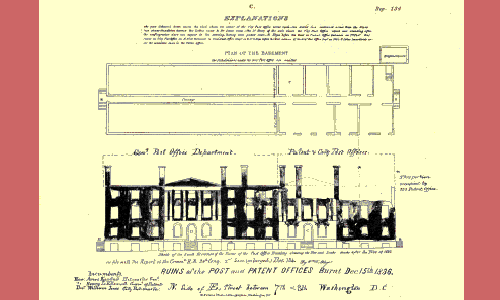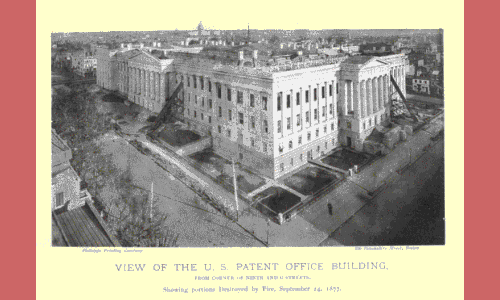




The United States Patent and Trademark Office uses one "hot" commodity...
|
The United States Patent and Trademark Office traces its origins back to the United States Constitution (Article I, Section 8), and the Patent Act of 1790 (1 Stat. 109), April 10, 1790. We've changed form and changed hands several times since then but one thing has remained the same: paper -- we receive, process and publish mountains of it daily. Paper, unfortunately, burns and we have not always been as lucky or as careful as we are today. |
|
We've learned the hard way about the difficulties that follow in the wake of the loss of records in a fire. Modern fire safety precautions and an awareness on the part of our employees regarding fire safety are two ways we deal with this danger. Another is the creation of duplicate records stored in separate locations and media, including our past use of microfilm and our evolving reliance on electronic copies of records which improve both individual employee access to records and sustained archival handling of these records. |
An act of war tempered by an act of mercy...
|
Our earliest experience with fire was an act of war. On August 25, 1814, the United States' patent models and papers narrowly escaped ruin when Dr. William Thornton pleaded for a little bit of sanity in an insane time. Dr. Thornton, who was building a musical instrument in the same building in which the patent papers and models were housed, learned of a British plan to attack and burn all the Government buildings in Washington, D.C. He persuaded the British that they would be destroying the common heritage of all mankind if they burned the Patent Office . When the smoke cleared from the dreadful attack, the Patent Office was the only Government building that was left untouched. |
It started out as such a good year for us...
|
The next time we faced fire, it was not from an act of war or malice, but from something which nearly every child now recognizes as something we should not do - the careless handling of ashes from fireplaces. It was in 1836, an otherwise very good year for the Patent Office, that the Great Fire struck. |
|
On July 4, 1836, the Patent Act of 1836 (5 Stat. 117) created the first Patent Office as a separate organization within the Department of State. Henry Leavitt Ellsworth was named as the organization's very first Commissioner and immediately began construction of a new fire-proof building just for the Patent Office. While awaiting completion of the new building, the Patent Office shared quarters with the General Post Office and Washington City Post Office. All 10,000 or so patent records and several thousand patent models were housed in about two fifths of the first floor, all of the second and all of the third floor of this shared building, known as Blodgett's Hotel. |
|
A fire-engine house was situated right at the corner of Blodgett's Hotel, complete with a fire engine, a forcing pump and 1000 feet of leather hose. This station and equipment had been provided by the U. S. Congress sixteen years earlier. They had demonstrated both the good sense and foresight to provide appropriate precautions against such things as fires. The station was manned by a volunteer fire fighting force. |
Analysis of a disaster...
|
We were doing everything right. We were concerned about fire. We had a fire station right next to our building. We were building a permanent fireproof home for our Office. So what went wrong? |
|
Well for starters, we were not actually in a fireproof building because it was still under construction. When the fire struck it was in the early hours of December 15, and it was cold outside. When it was cold outside in 1836, people usually heated buildings with firewood. In a city like Washington DC, people usually stored firewood inside the same building where it was used, and we were no exception. The Patent Office and Postal employees stored wood for their fireplaces in separate wooden bins in the drafty, dank cellar of the building. The stage was set for a fire in the cellar, but a spark was needed. |
|
That spark finally came from something that employees of both the City Post Office and the Patent Office had been warned against doing. It was the practice by City Post Office clerks of storing ashes in the cellar hallway and by Patent Office messengers who stored ashes in a wooden box in the corner of the fuel room. The messengers and clerks were warned, but there was no trash pickup and nowhere else to put the ashes but in the street, which is what the General Post Office employees did do. Warnings were disregarded without consequence and it was our undoing. |
|
At 3:00 in the morning on December 15, 1836, a messenger who was quartered in the building awoke to suffocating smoke. He roused others in the building who searched for the source of the smoke and finally found it coming from the cellar. The few employees who could get there in time tried in vain to enter the Patent Office portion of the building, encountering blocked doors, heavy smoke and windows too high to get to. While some folks ran for help, others began removing those records that they could get to from the Post Offices. |
To the rescue???????...
|
The fire engine was called. After all, it was right on the corner, but it had been 16 years since the equipment was bought and things had fallen into disrepair. The volunteers quickly found that the leather hose had disintegrated and the fire pump was useless. They desperately formed a bucket brigade while others ran to another fire station to get working equipment. By the time a working fire engine arrived, it was too late. The building was doomed after the first 15 to 20 minutes of the fire and people could do little more than protect the surrounding buildings from being swallowed up by the inferno. |
|
Everything in the Patent Office was lost to the Great Fire, including the musical instrument saved by Dr. Thornton in 1814. Our predecessors were faced with the mammoth task of restoring records and patent models. There were no patent records at hand save those in the mind of our single patent examiner and a book that a draftsman named William Steiger had borrowed from the Patent Office despite official rules that prohibited their removal from the Office. It was an instance where not following the rules actually saved a little bit of history. |

The U. S. Patent and Trademark Office has X-Files.....
|
In the 46 years prior to the Great Fire, the United States government had issued about 10,000 patents. Most of these could never be revived again, but Congress acted to restore those records that could be reconstructed from private files and reproduce models which were deemed critical. Patents whose records were not restored were cancelled. There were a total of 2,845 patents restored, most of which were eventually given a number beginning with "X". All patents after the date of the establishment of the Patent Office in July 1836 were numbered as a new series (without the X), beginning with a new Patent No. 1 to John Ruggles. A small number of the new series patents had been destroyed in the Great Fire but they were quickly recovered from their owners' records. |
One more time....
|
We survived another "trial by fire" on September 24, 1877. This second fire struck in the "fire-proof" building that we had started constructing in 1836. The building may have been fire-proof, but its contents were not! Many patent models were devoured in the flames. Despite the loss of many models, we fared far better than we had in 1836 because the important records which illustrated and described all the inventions were saved. |

|
In the ensuing years, we have faced the threat of losses during moves, damage from broken water pipes, breakage of file storage racks, and general wear and tear but never anything so disastrous as the Great Fire of 1836. We employ modern fire safety and record management practices, and enjoy access to some of the finest local professional fire fighting services in the country. |
|
We do more than just hope to never have to look back on another Great Fire, we work every day to prevent such a disaster from occurring and take precautions to protect, preserve and archive our records - the common heritage of all mankind . The only fuel we now want our patent system to be known as is the one referred to in this quote from Abraham Lincoln: "The patent system added the fuel of interest to the fire of genius." |
|
[ USPTO
Home ][ Kids' Home ][ Twinkle
Lights ][ Bright Lights ][ Guiding
Lights ][ Fun
House ]
[ imagination machine ][ whowhatwhenwherehowwhy ][ time machine ] [ games ][ puzzles ][ links ][ help ][ search ] [ Legal Disclaimer ][ Privacy ] |